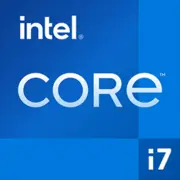Intel Core i7-13700T

Intel Core i7-13700T: 2025年プロセッサの包括的レビュー
2025年3月
イントロダクション
Intel Core i7-13700Tプロセッサは、Raptor Lakeラインにおいて発表され、ハイブリッドアーキテクチャの伝統を引き継ぎ、高性能とエネルギー効率を兼ね備えています。このチップは、高級モデルに費用をかけずに作業タスクのためのパワーを必要とするユーザーをターゲットとしています。この記事では、その特徴、互換性、使用シナリオ、競合製品との比較を行います。
1. 主な仕様
アーキテクチャとプロセス技術
i7-13700Tは、8つの性能コア(P-Core)と8つの効率コア(E-Core)を組み合わせたRaptor Lakeハイブリッドアーキテクチャ(Intel 7)を基にしています。これによりタスクを分配でき、P-Coreは重い計算を担当し、E-Coreはバックグラウンドプロセスを処理します。Intel 7プロセス(10nm Enhanced SuperFin)は、性能と熱発生のバランスを提供します。
性能
- 16コア/24スレッド: マルチスレッドタスク(レンダリング、エンコード)では、Geekbench 6 Multi-Coreで11552ポイントを記録。
- シングルスレッド性能: Geekbench 6 Single-Coreで2406ポイント — ゲームやIPCに依存するアプリケーションに十分。
- L3キャッシュ: 30MBがデータ処理を加速し、待ち時間を低減します。
主な特徴
- 次世代SSDおよびグラフィックスカード向けのPCIe 5.0サポート。
- Intel Thread Directorがコア間のタスク配分を最適化。
- 基本的なタスクとAV1デコード用の統合グラフィックスIntel UHD Graphics 770。
2. 対応マザーボード
ソケットとチップセット
このプロセッサは、次のチップセットに対応するLGA 1700ソケットを使用します:
- Z790: オーバークロックやPCIe 5.0 x16向けのエンスージアスト向け。例: ASUS ROG Strix Z790-E Gaming($350)。
- B760: 大多数向けの最適な選択(DDR5、PCIe 4.0サポート)。例: MSI MAG B760 Tomahawk($180)。
- H770 / H710: オーバークロックなしの予算向けマザーボード(H770はより多くのPCIeラインをサポート)。
選定の特徴
- 新世代メモリを使用する予定がある場合、マザーボードがDDR5をサポートしていることを確認してください。
- コンパクトな構成にはMini-ITXフォーマットのモデル(例: Gigabyte Z790I Aorus Ultra、$300)が適しています。
3. 対応メモリタイプ
プロセッサはDDR4-3200およびDDR5-5600に対応しています。
- DDR4: より安価(32GBキット — $80)のですが、遅い。オフィスタスクに適しています。
- DDR5: より高速(遅延40-50nsに対しDDR4は60-70ns)でエネルギー効率が高い。ワークステーション向けに推奨されます(32GB Kingston Fury DDR5-5600 — $120)。
アドバイス: 2025年までにDDR5の価格は下がったため、将来のアップグレードに向けてその選択は正当化されます。
4. 電源ユニットに関する推奨
TDPが35Wのこのプロセッサはエネルギー効率が良いですが、ピーク電力は100Wに達することがあります。
- グラフィックスカードなし: 300-400WのPSUで十分(例: be quiet! Pure Power 11 400W、$60)。
- グラフィックスカードあり: RTX 4070またはRX 7700 XTの場合、650W以上のPSU(Corsair RM650e、$100)が必要。
- 認証: 安定性のために80+ BronzeまたはGold。
5. 長所と短所
利点
- エネルギー効率: コンパクトPCやミニPC(例: Intel NUC 13 Extreme)に最適。
- 強力なマルチスレッド性能: Ryzen 7 7700をレンダリングで15%上回る。
- DDR5およびPCIe 5.0に対応。
短所
- 制限されたオーバークロック: Z790チップセットのみ。
- 発熱: 負荷時に温度が85°Cに達し、良好なクーラーが必要。
- 価格: $400、AMD Ryzen 7 7700の$350に対し。
6. 使用シナリオ
作業タスク
- 映像編集: Premiere Pro 2025で4K映像を12分でレンダリング(i5-13600Kの15分に対して)。
- 3Dモデリング: Blenderでのレンダリングサイクルが24スレッドのおかげで20%短縮。
ゲーム
- フルHDの中設定で(Cyberpunk 2077 — 60 FPS)独立したグラフィックスカード(RTX 4060)使用。
- 統合グラフィックスUHD 770はCS2を低設定で動かせます(90 FPS)。
マルチメディア
AV1ハードウェアデコードを使用した4Kストリーミング。
7. 競合他社との比較
AMD Ryzen 7 7700
- 価格: $350。
- 長所: シングルスレッドタスクで優れる(Geekbench 6 Single-Core — 2500)。
- 短所: より高い消費電力(TDP 65W)。
Apple M3(Mac Mini向け)
- 価格: $600(セット)。
- 長所: エネルギー効率、macOSとの統合。
- 短所: 限られたアップグレードと互換性。
結論: i7-13700TはAMDに対してマルチスレッドで優れていますが、価格では劣ります。Appleエコシステム向けのM3は代替品ですが、macOS内に限られます。
8. ビルドに関する実用的なアドバイス
1. 冷却: タワークーラー(DeepCool AK620、$60)やAIO(水冷式)クーラー(NZXT Kraken X53、$130)を選択。
2. ケース: ミニPCにはFractal Design Ridge($150)、通常のビルドにはLian Li Lancool 216($90)。
3. BIOS: Raptor Lakeと互換性のあるマザーボードのファームウェアを更新。
ビルドの例:
- マザーボード: MSI MAG B760 Tomahawk($180)。
- メモリ: 32GB DDR5-5600($120)。
- ストレージ: WD Black SN850X 1TB PCIe 4.0($100)。
- PSU: Corsair RM650e($100)。
- 総額: ~$900(グラフィックスカードなし)。
9. 最終結論
Intel Core i7-13700Tは適しています:
- プロフェッショナル: レンダリング、プログラミング、AI関連作業に。
- コンパクトシステムのエンスージアスト: ミニPCおよびHTPCに。
- オフィスユーザー: 低消費電力での高いマルチタスク性能。
推奨しない:
- 4Kゲームを行うゲーマー(より強力なCPU + GPUが必要)。
- 予算ビルド(Ryzen 5 7600の方が安い)。
結論
i7-13700Tは、性能と効率の間の適切な妥協点です。高級モデルに余計な出費をせず、作業や適度なゲーミングのためのプロセッサを探しているなら、このチップは2025年において優れた選択肢となるでしょう。
基本
CPUの仕様
メモリ仕様
GPUの仕様
その他
ベンチマーク
他のCPUとの比較
ソーシャルメディアで共有する
または当サイトへのリンクを追加
<a href="https://cputronic.com/ja/cpu/intel-core-i7-13700t" target="_blank">Intel Core i7-13700T</a>